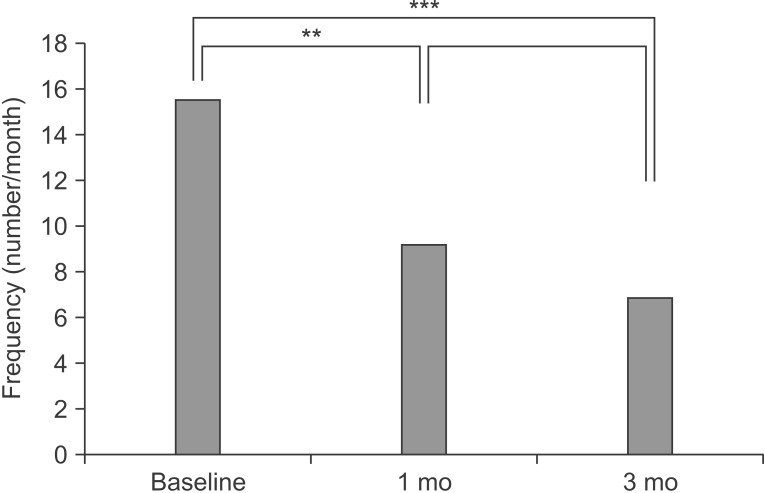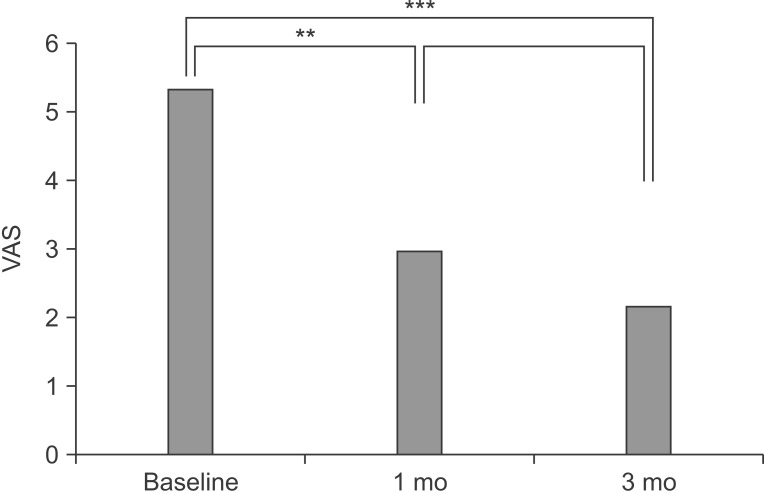Ann Rehabil Med.
2015 Dec;39(6):905-913. 10.5535/arm.2015.39.6.905.
Effect of Custom-Molded Foot Orthoses on Foot Pain and Balance in Children With Symptomatic Flexible Flat Feet
- Affiliations
-
- 1Department of Physical Medicine and Rehabilitation, Inje University Ilsan Paik Hospital, Goyang, Korea. I9534@paik.ac.kr
- 2Institute of Sports Rehabilitation, Inje University Ilsan Paik Hospital, Goyang, Korea.
- KMID: 2165616
- DOI: http://doi.org/10.5535/arm.2015.39.6.905
Abstract
OBJECTIVE
To evaluate the effect of custom-molded foot orthoses on foot pain and balance in children with symptomatic flexible flat foot 1 month and 3 months after fitting foot orthosis. METHOD: A total of 24 children over 6 years old with flexible flat feet and foot pain for at least 6 months were recruited for this study. Their resting calcaneal stance position and calcaneal pitch angle were measured. Individual custom-molded rigid foot orthoses were prescribed using inverted orthotic technique to control foot overpronation. Pain questionnaire was used to obtain pain sites, degree, and frequency. Balancing ability was determined using computerized posturography. These evaluations were performed prior to custom-molded foot orthoses, 1 month, and 3 months after fitting foot orthoses. RESULT: Of 24 children with symptomatic flexible flat feet recruited for this study, 20 completed the study. Significant (p<0.001) improvements in pain degree and frequency were noted after 1 and 3 months of custom-molded foot orthoses. In addition, significant (p<0.05) improvement in balancing ability was found after 3 months of custom-molded foot orthoses.
CONCLUSION
Short-term use of custom-molded foot orthoses significantly improved foot pain and balancing ability in children with symptomatic flexible flat foot.
Figure
Cited by 2 articles
-
Effect of Foot Orthoses in Children With Symptomatic Flexible Flatfoot Based on Ultrasonography of the Ankle Invertor and Evertor Muscles
Dong Joon Cho, So Young Ahn, Soo-Kyung Bok
Ann Rehabil Med. 2021;45(6):459-470. doi: 10.5535/arm.21137.Change in Plantar Pressure and Plain Radiography in Pediatric Flexible Flatfoot: A Retrospective Cohort Study
Sungjoon Kim, Yong Gyun Kim, Jun Yup Kim, Si-Bog Park, Kyu Hoon Lee
Ann Rehabil Med. 2024;48(5):352-359. doi: 10.5535/arm.240041.
Reference
-
1. Sullivan JA. Pediatric flatfoot: evaluation and management. J Am Acad Orthop Surg. 1999; 7:44–53. PMID: 9916191.
Article2. Garcia-Rodriguez A, Martin-Jimenez F, Carnero-Varo M, Gomez-Gracia E, Gomez-Aracena J, Fernandez-Crehuet J. Flexible flat feet in children: a real problem? Pediatrics. 1999; 103:e84. PMID: 10353981.3. Kim SB, Yoon K, Park HS, Kwak H, Ha NJ, Park JS. Radiologic measurement of flatfoot. J Korean Acad Rehabil Med. 2000; 24:995–1001.4. Harris EJ, Vanore JV, Thomas JL, Kravitz SR, Mendelson SA, Mendicino RW, et al. Diagnosis and treatment of pediatric flatfoot. J Foot Ankle Surg. 2004; 43:341–373. PMID: 15605048.
Article5. Staheli LT, Chew DE, Corbett M. The longitudinal arch: a survey of eight hundred and eighty-two feet in normal children and adults. J Bone Joint Surg Am. 1987; 69:426–428. PMID: 3818704.6. Mosca VS. Flexible flatfoot in children and adolescents. J Child Orthop. 2010; 4:107–121. PMID: 21455468.
Article7. Fabry G. Clinical practice. Static, axial, and rotational deformities of the lower extremities in children. Eur J Pediatr. 2010; 169:529–534. PMID: 20052491.8. Yagerman SE, Cross MB, Positano R, Doyle SM. Evaluation and treatment of symptomatic pes planus. Curr Opin Pediatr. 2011; 23:60–67. PMID: 21169838.9. Nemeth B. The diagnosis and management of common childhood orthopedic disorders. Curr Probl Pediatr Adolesc Health Care. 2011; 41:2–28. PMID: 21195338.
Article10. Houghton KM. Review for the generalist: evaluation of pediatric foot and ankle pain. Pediatr Rheumatol Online J. 2008; 6:6. PMID: 18400098.
Article11. Yan GS, Yang Z, Lu M, Zhang JL, Zhu ZH, Guo Y. Relationship between symptoms and weight-bearing radiographic parameters of idiopathic flexible flatfoot in children. Chin Med J (Engl). 2013; 126:2029–2033. PMID: 23769552.12. Lin CJ, Lai KA, Kuan TS, Chou YL. Correlating factors and clinical significance of flexible flatfoot in preschool children. J Pediatr Orthop. 2001; 21:378–382. PMID: 11371824.
Article13. Evans AM, Rome K, Peet L. The foot posture index, ankle lunge test, Beighton scale and the lower limb assessment score in healthy children: a reliability study. J Foot Ankle Res. 2012; 5:1. PMID: 22230105.
Article14. Krul M, van der Wouden JC, Schellevis FG, van Suijlekom-Smit LW, Koes BW. Foot problems in children presented to the family physician: a comparison between 1987 and 2001. Fam Pract. 2009; 26:174–179. PMID: 19270034.
Article15. Pfeiffer M, Kotz R, Ledl T, Hauser G, Sluga M. Prevalence of flat foot in preschool-aged children. Pediatrics. 2006; 118:634–639. PMID: 16882817.
Article16. Powell M, Seid M, Szer IS. Efficacy of custom foot orthotics in improving pain and functional status in children with juvenile idiopathic arthritis: a randomized trial. J Rheumatol. 2005; 32:943–950. PMID: 15868634.17. Whitford D, Esterman A. A randomized controlled trial of two types of in-shoe orthoses in children with flexible excess pronation of the feet. Foot Ankle Int. 2007; 28:715–723. PMID: 17592702.
Article18. Benedetti MG, Ceccarelli F, Berti L, Luciani D, Catani F, Boschi M, et al. Diagnosis of flexible flatfoot in children: a systematic clinical approach. Orthopedics. 2011; 34:94. PMID: 21323297.
Article19. Bok SK, Kim BO, Lim JH, Ahn SY. Effects of custom-made rigid foot orthosis on pes planus in children over 6 years old. Ann Rehabil Med. 2014; 38:369–375. PMID: 25024961.
Article20. Valmassy RL. Clinical biomechanics of the lower extremities. 1st ed. New York: Mosby;1996. p. 243–277.21. Blake RL. Inverted functional orthosis. J Am Podiatr Med Assoc. 1986; 76:275–276. PMID: 3712254.
Article22. Rome K, Ashford RL, Evans A. Non-surgical interventions for paediatric pes planus. Cochrane Database Syst Rev. 2010; (7):CD006311. PMID: 20614443.
Article23. Evans AM, Rome K. A Cochrane review of the evidence for non-surgical interventions for flexible pediatric flat feet. Eur J Phys Rehabil Med. 2011; 47:69–89. PMID: 21448121.24. Wenger DR, Mauldin D, Speck G, Morgan D, Lieber RL. Corrective shoes and inserts as treatment for flexible flatfoot in infants and children. J Bone Joint Surg Am. 1989; 71:800–810. PMID: 2663868.
Article25. Lorimer D, French G, O'Donnell M. Neale's disorders of the foot: diagnosis and management. 6th ed. Edinburgh: Churchill Livingstone;2002. p. 306–307.26. Travell JG, Simons DG. Travell & Simons' myofascial pain and dysfunction: the trigger point manual. . Baltimore: Williams & Wilkins;1992. p. 460–461.27. Leung AK, Mak AF, Evans JH. Biomedical gait evaluation of the immediate effect of orthotic treatment for flexible flat foot. Prosthet Orthot Int. 1998; 22:25–34. PMID: 9604273.
- Full Text Links
- Actions
-
Cited
- CITED
-
- Close
- Share
- Similar articles
-
- Long Term Effect of Custom-Molded Foot Orthoses on Foot Pain and Balance in Children with Symptomatic Flexible Flat Feet
- Effect of Foot Orthoses on Children With Lower Extremity Growing Pains
- The Effect of Insole to Flexible Flat Foot on Dynamic Balance and Ankle Muscle Activity during the Y-Balance Test
- Long-Term Effect of Rigid Foot Orthosis in Children Older Than Six Years With Flexible Flat Foot
- Effect of Foot Orthoses in Children With Symptomatic Flexible Flatfoot Based on Ultrasonography of the Ankle Invertor and Evertor Muscles




